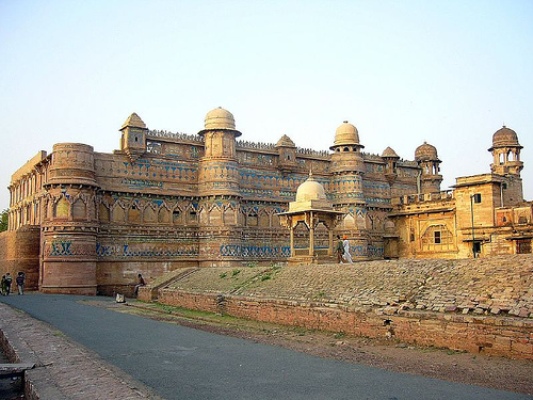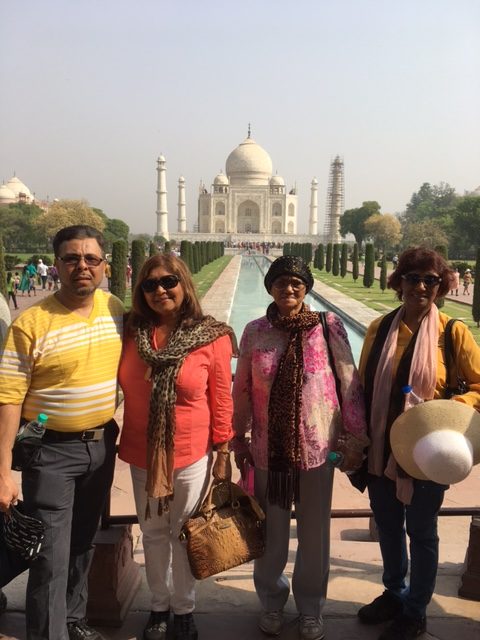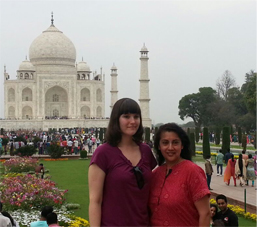Gwalior is the capital of the erstwhile princely state ruled by the Scindias. The history of Gwalior predates the Scindia dynasty and this makes Gwalior a wonderful destination. Gwalior is also final home to one of the greatest non-royal individuals in Indian history-Tansen. Tansen, the legendary singer of Mughal Emperor Akbar’s court is buried in this city. Gwalior is also known for its heritage of the Great Gwalior School of singing, exquisite Jain and Hindu temples.
At the heart of Gwalior is its fortress the Gwalior Fort, built by Raja Man Singh Tomar, of the Tomar dynasty in the 11th century and continued to be added till 16th c. This formidable structure had the reputation of being one of the most invincible forts of India. It occupies an isolated rock outcrop and its steepness makes it virtually unscalable. The fort is surrounded by high walls which enclose buildings from several periods. Inside the fort walls other than the royal complex are beautiful Hindu temples, a historic Sikh Gurudwara and 15th century Jain caves with massive rock-cut sculptures of Jain saints. These Jain caves have a series of rock-cut sculptures, excavated in the rock on all sides, and numbering nearly a hundred, great and small. One of the colossal figures is 57 ft (17 m) high, which is taller than any other in northern India. Gwalior is the part of central India tour.
Visit the splendid 19the century Jai Vilas Palace patterned on the style of the ‘Palais de Versailles’ in France combines Tuscan, Italian and Corinthian styles of architecture. This current residence of the Scindia family has partly been turned into the Jivaji Rao Scindia Museum. The 25 rooms of the palace are evocative of a lavish regal lifestyle. The imposing Darbar Hall has two central chandeliers weighing a couple of tonnes . These chandeliers were hung only after ten elephants had tested the strength of the roof. Other attractions are; a silver train with cut-glass wagons which served guests as it chugged around the table on miniature rails; a glass cradle from Italy used for the baby Krishna each Janmashtami, silver dinner services and swords that were once worn by Aurangzeb and Shah Jahan. Visit the 15th century Gujari Mahal, a monument to the love of Raja Mansingh Tomar for his Gujar Queen, Mrignayani who belonged to a low caste. The outer structure of Gujari Mahal has survived in an almost total state of preservation; the interior has been converted into Archaeological Museum housing rare antiquities, some of them dating back to the 1st century A.D.
Posted in India Travel Guide and tagged Unexplored Gwalior on .



 mazing vacation thanks to Indivine Journeys. I had traveled to India several times and had booked the hotel rooms, drivers, etc. thinking that (1) it would cost us less that way and (2) I would have m...
mazing vacation thanks to Indivine Journeys. I had traveled to India several times and had booked the hotel rooms, drivers, etc. thinking that (1) it would cost us less that way and (2) I would have m...  Hi Zaki: salaam . I want to thank you very much for planning an absolute wonderful vacation for my me n my husband, my mother n sister. The golden triangle tour was amazing n our driver and his son were so wonderful. We could...
Hi Zaki: salaam . I want to thank you very much for planning an absolute wonderful vacation for my me n my husband, my mother n sister. The golden triangle tour was amazing n our driver and his son were so wonderful. We could...  Dear Mr. Zaki, My daughter and I had a great time in India. Guide was extremely helpful in all aspect of handling the travel for us and made us feel very comfortable. Thank you again for setting up the trip for us. I think...
Dear Mr. Zaki, My daughter and I had a great time in India. Guide was extremely helpful in all aspect of handling the travel for us and made us feel very comfortable. Thank you again for setting up the trip for us. I think...  Thank you Mr. Zaki, Happy Holi to all in India. We had a wonderful time in India and we have lots of memories. Thanks for your hard work and attention to detail. We look forward to traveling with you again.
Thank you Mr. Zaki, Happy Holi to all in India. We had a wonderful time in India and we have lots of memories. Thanks for your hard work and attention to detail. We look forward to traveling with you again.